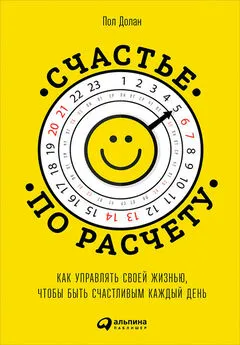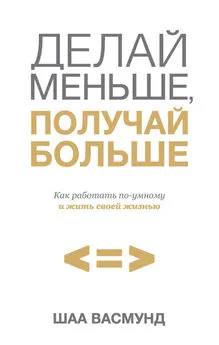Пол Долан - Счастье по расчету. Как управлять своей жизнью, чтобы быть счастливым каждый день
- Название:Счастье по расчету. Как управлять своей жизнью, чтобы быть счастливым каждый день
- Автор:
- Жанр:
- Издательство:Альпина Паблишер
- Год:2015
- Город:Москва
- ISBN:978-5-9614-3060-8
- Рейтинг:
- Избранное:Добавить в избранное
-
Отзывы:
-
Ваша оценка:
Пол Долан - Счастье по расчету. Как управлять своей жизнью, чтобы быть счастливым каждый день краткое содержание
Счастье по расчету. Как управлять своей жизнью, чтобы быть счастливым каждый день - читать онлайн бесплатно ознакомительный отрывок
Интервал:
Закладка:
260
De La Ronde C., Swann W.B. Partner verification: restoring shattered images of our intimates. Journal of Personality and Social Psychology 1998; 75: 374.
261
Шуровьески Дж. Мудрость толпы. Почему вместе мы умнее, чем поодиночке, и как коллективный разум влияет на бизнес, экономику, общество и государство. – Манн, Иванов и Фербер, 2014.
262
Bargh J.A., Williams E.L. The automaticity of social life. Current Directions in Psychological Science 2006; 15: 1–4.
263
Dimberg U., Thunberg M. Unconscious facial reactions to emotional facial expressions. Psychological Science 2000; 11: 86.
264
Parkinson B., Simons G. Affecting others: social appraisal and emotion contagion in everyday decision making. Personality and Social Psychology Bulletin 2009; 35: 1071–84.
265
Totterdell P. Catching moods and hitting runs: mood linkage and subjective performance in professional sport teams. Journal of Applied Psychology 2000; 85: 848.
266
McIntosh D.N. Spontaneous facial mimicry, liking and emotional contagion. Polish Psychological Bulletin 2006; 37: 31.
267
Larson R.W., Richards M.H. Family emotions: do young adolescents and their parents experience the same states? Journal of Research on Adolescence 1994; 4: 567–83.
268
Putnam R.D. Bowling alone: the collapse and revival of American community. Simon & Schuster, 2001.
269
Luttmer E. Neighbors as negatives: relative earnings and well-being. Quarterly Journal of Economics 2005; 120: 963–1002.
270
Card D., Mas A., Moretti E., Saez E. Inequality at work: the effect of peer salaries on job satisfaction. American Economic Review 2012; 102: 2981–3003.
271
Senik C. When information dominates comparison: learning from Russian subjective panel data. Journal of Public Economics 2004; 88: 2099–2123; Akay A., Bargain O., Zimmermann K.F. Relative concerns of rural-to-urban migrants in China. Journal of Economic Behavior & Organization 2012; 81: 421–41.
272
Blanton H., Crocker J., Miller D.T. The effects of in-group versus out-group social comparison on self-esteem in the context of a negative stereotype. Journal of Experimental Social Psychology 2000; 36: 519–30.
273
Wadsworth T. Sex and the pursuit of happiness: how other people’s sex lives are related to our sense of well-being. Social Indicators Research 2013; 1–21.
274
Дахигг Ч. Сила привычки. Почему мы живем и работаем именно так, а не иначе. – Карьера Пресс, 2015.
275
Hofmann W., Friese M., Wiers R.W. Impulsive versus reflective influences on health behavior: a theoretical framework and empirical review. Health Psychology Review 2008; 2: 111–37.
276
Henningfield J.E., Cohen C., Slade J.D. Is nicotine more addictive than cocaine? British Journal of Addiction 1991; 86: 565–69.
277
Christakis N.A., Fowler J.H. The collective dynamics of smoking in a large social network. New England Journal of Medicine 2008; 358: 2249–58.
278
Lally P., van Jaarsveld C., Potts H., Wardle J. How are habits formed: modelling habit formation in the real world. European Journal of Social Psychology 2010; 40: 998–1009.
279
Verplanken B., Wood W. Interventions to break and create consumer habits. Journal of Public Policy & Marketing 2006; 25: 90–103.
280
Bernheim B.D., Rangel A. Addiction and cue-triggered decision processes. American Economic Review 2004; 94: 1558–90.
281
Wood W., Tam L., Witt M.G. Changing circumstances, disrupting habits. Journal of Personality and Social Psychology 2005; 88: 918.
282
Чиксентмихайи М. Поток. Психология оптимального переживания. – Альпина нон-фикшн, 2015.
283
Van Boven L., Gilovich T. To do or to have? That is the question. Journal of Personality and Social Psychology 2003; 85: 1193–1202.
284
Frank R.H. How not to buy happiness. Daedalus 2004; 133: 69–79.
285
Carter T.J., Gilovich T. The relative relativity of material and experiential purchases. Journal of Personality and Social Psychology 2010; 98: 146–59.
286
Van Boven L., Campbell M.C., Gilovich T. Stigmatizing materialism: on stereotypes and impressions of materialistic and experiential pursuits. Personality and Social Psychology Bulletin 2010; 36: 551–63.
287
Nicolao L., Irwin J.R., Goodman J.K. Happiness for sale: do experiential purchases make consumers happier than material purchases? Journal of Consumer Research 2009; 36: 188–98.
288
Olsson L.E., Gӓrling T., Ettema D., Friman M., Fujii S. Happiness and satisfaction with work commute. Social Indicators Research 2013; 111: 255–63.
289
Nelson L.D., Meyvis T., Galak J. Enhancing the television-viewing experience through commercial interruptions. Journal of Consumer Research 2009; 36: 160–72.
290
Baird B., Smallwood J., Mrazek M.D., Kam J.W., Franklin M.S., Schooler JW. Inspired by distraction: mind wandering facilitates creative incubation. Psychological Science 2012; 23: 1117–22.
291
Dolan P., Metcalfe R. The relationship between innovation and subjective wellbeing. Research Policy 2012; 41: 1489–98.
292
Ruef M. Strong ties, weak ties and islands: structural and cultural predictors of organizational innovation. Industrial and Corporate Change 2002; 11: 427–49.
293
Тейлор С. Покорение времени. Как время воздействует на нас, а мы на время. – М.: Альпина нон-фикшн, 2010.
294
Block R.A., Zakay D., Hancock P.A. Developmental changes in human duration judgments: a meta-analytic review. Developmental Review 1999; 19: 183–211.
295
Ahn H.K., Liu M.W., Soman D. Memory markers: how consumers recall the duration of experiences. Journal of Consumer Psychology 2009; 19: 508–16.
296
DeNeve K., Cooper H. The happy personality: a meta-analysis of 137 personality traits and subjective well-being. Psychological Bulletin 1998; 124: 197–229.
297
Koelsch S. Towards a neural basis of music-evoked emotions. Trends in Cognitive Sciences 2010; 14: 131–37.
298
Guzzetta C.E. Effects of relaxation and music therapy on patients in a coronary care unit with presumptive acute myocardial infarction. Heart & Lung: The Journal of Critical Care 1989; 18: 609; Nayak S., Wheeler B.L., Shiflett S.C., Agostinelli S. Effect of music therapy on mood and social interaction among individuals with acute traumatic brain injury and stroke. Rehabilitation Psychology 2000; 45: 274; Bensimon M., Amir D., Wolf Y. Drumming through trauma: music therapy with post-traumatic soldiers. The Arts in Psychotherapy 2008; 35: 34–48; Gold C., Voracek M., Wigram T. Effects of music therapy for children and adolescents with psychopathology: a meta-analysis. Journal of Child Psychology and Psychiatry 2004; 45: 1054–63.
299
Sacks O. The power of music. Brain 2006; 129: 2528–32.
300
Szabo A. The acute effects of humor and exercise on mood and anxiety. Journal of Leisure Research 2003; 35: 152–62.
301
Berk L.S., Felten D.L., Tan S.A., Bittman B.B., Westengard J. Modulation of neuroimmune parameters during the eustress of humor-associated mirthful laughter. Alternative Therapies in Health and Medicine 2001; 7: 62–76.
302
Yovetich N.A., Dale T.A., Hudak M.A. Benefits of humor in reduction of threat-induced anxiety. Psychological Reports 1990; 66: 51–58.
303
Tse M., Lo A., Cheng T., Chan E., Chan A., Chung H. Humor therapy: relieving chronic pain and enhancing happiness in older adults. Journal of Aging Research 2010.
304
Van Wormer K., Boes M. Humor in the emergency room: a social work perspective. Health Social Work 1997; 22: 87–92.
305
Potter C., Carpenter J. Fathers’ involvement in Sure Start: what do fathers and mothers perceive as benefits? Practice: Social Work in Action 2010; 22: 3–15.
306
Ruch W. The sense of humor: explorations of a personality characteristic. Vol. 3. Walter de Gruyter, 1998.
307
Carpenter K.M., Stoner S.A., Mundt J.M., Stoelb B. An online self-help CBT intervention for chronic lower back pain. Clinical Journal of Pain 2012; 28: 14–22.
308
Brown L.A., Gaudiano B.A., Miller I.W. Investigating the similarities and differences between practitioners of second-and third-wave cognitive-behavioral therapies. Behavior Modification 2011; 35: 187–200.
309
Davidson R.J., Kabat-Zinn J., Schumacher J., et al. Alterations in brain and immune function produced by mindfulness meditation. Psychosomatic Medicine 2003; 65: 564–70; Teasdale J.D., Segal Z.V., Mark J., et al. Prevention of relapse/recurrence in major depression by mindfulness-based cognitive therapy. Journal of Consulting and Clinical Psychology 2000; 68: 615–23.
310
Lim C., Putnam R.D. Religion, social networks, and life satisfaction. American Sociological Review 2010; 75: 914–33.
311
Stevens N. Gender and adaptation to widowhood in later life. Ageing & Society 1995; 15: 37–58.
312
Fowler J.H., Christakis N.A. The dynamic spread of happiness in a large social network. British Medical Journal 2008; 337: a2338.
313
Лерер Дж. Вообрази. Как работает креативность. – М.: АСТ, Corpus, 2013.
314
Cain S. Quiet: the power of introverts in a world that can’t stop talking. Penguin, 2012; Lucas R.E., Diener E. Understanding extraverts’ enjoyment of social situations: the importance of pleasantness. Journal of Personality and Social Psychology 2001; 81: 343–56.
Читать дальшеИнтервал:
Закладка:










